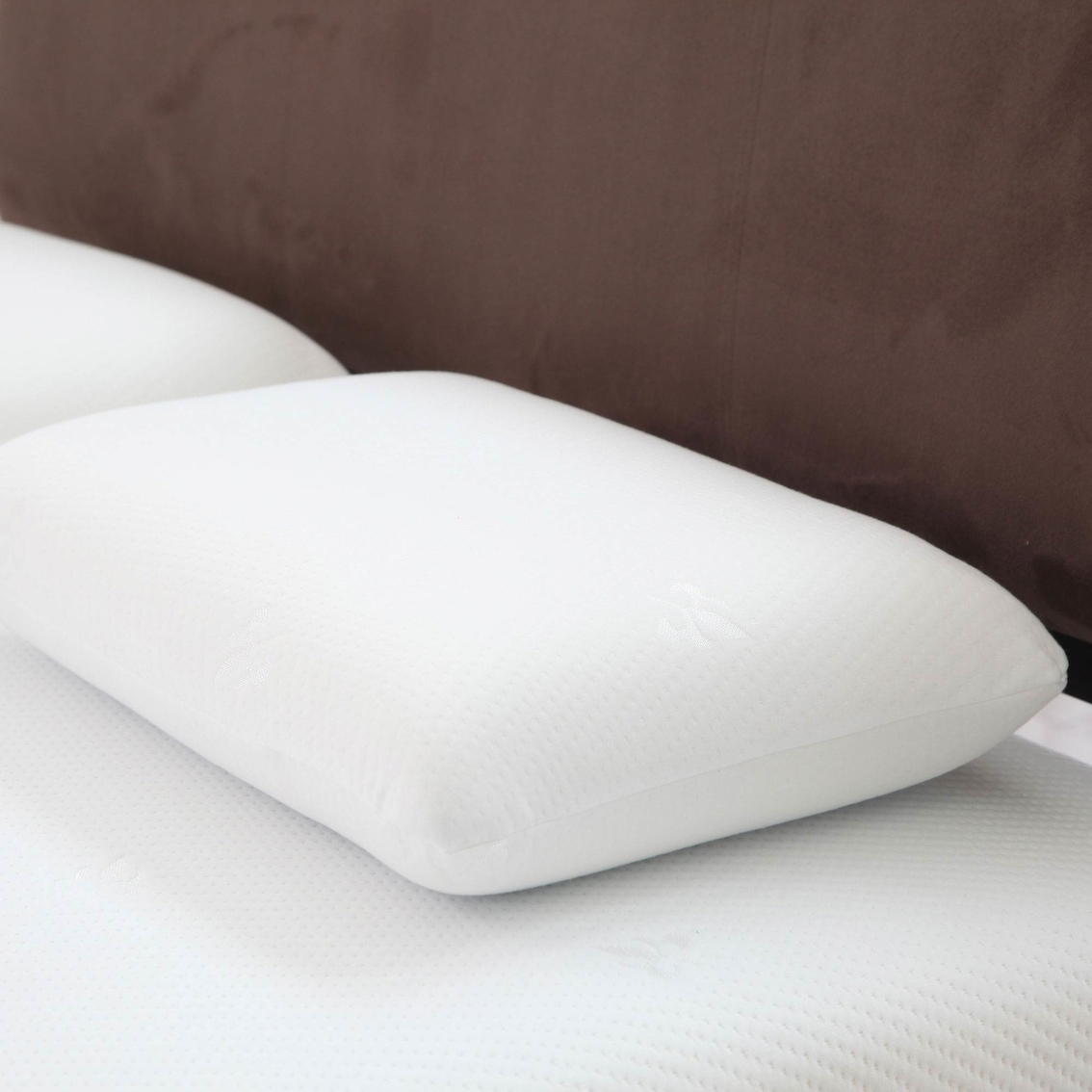Finding the best pillow for your rest preferences is essential to a good night’s sleep.
After reading this you will be able to:
- Realise what type of sleeper you are
- Test your pillow to see if you need a new one
- Know how long adjusting to a new pillow takes
- Identify the most suitable pillow for allergy sufferers
- Understand which type of support is best for your head
- Confidently choose between cotton, silk, viscose, or polyester cover casings
- Decide if you prefer down, synthetic down, feather, memory foam, gel, latex or wool pillow fillings

Tired Of Pillow Problems Costing You Sleep?
You rub the back of your neck. Your eyes weigh heavy. You snap at family, friends and colleagues.
Feeling exhausted, you pray that tonight will bring better sleep. You know it won’t, and continue ambling through the day. According to Rand Europe poor sleep may be costing the UK economy up to £40 billion a year.
We may only spend a third of our time in bed, but it’s a vital element in dictating the quality of our entire lives. Ensuring you have the right pillow for your needs is therefore of the utmost importance. A good pillow will keep your neck aligned with your spine and prevent muscle stiffness, nerve pain, tendonitis, herniated discs and headaches.
Even if you’re not yet experiencing any discomfort, you should consider safeguarding the future quality of your sleep by investing in the best pillow for your needs. One that was once ideal may now be lumpy and deflated, or riddled with dust mites. Ignoring the condition of your pillow is a guaranteed way to ensure poor quality sleep will eventually creep up on you.
How To Test Your Pillow
Pillows are rarely at their best after 2 years, and most should be replaced at this time. By conducting a simple test you can reveal the state of wear and tear on your pillow, even before you have yet to feel any ill effects.
- Place the pillow on a flat surface such as a table.
- Fold the pillow over in half.
- Let go and observe how it reacts.
If your pillow immediately springs back into shape then there is likely still some use left in it. A very slow return to form however, or failure to restore itself at all, is a clear indication that it needs replacing.
Being able to recognise the need for a new pillow can be easy enough. The difficult part is distinguishing which pillow best suits your needs from the many options available. A poor choice of pillow can invite further discomfort, while an outright bad one might find you battling even more intense sleep deprivation, headaches, neck, back and shoulder pain.


How Do I Find The Best Pillow For Me?
There are many facets to consider when selecting a great pillow, but they can essentially be condensed into two questions:
Material – Is it something you find comfortable?
Support – Will it keep your spine aligned in a neutral position?
Choosing The Best Fabric For Pillow Covers
The pillow cover is responsible for the feel on your skin. It is therefore very important to choose one with a texture that doesn’t irritate, and allows you to get comfortable enough for a good night’s sleep.
Cotton Covers
Due to being soft and breathable, cotton is one of the most popular choices of pillow for many sleepers. For those who profusely sweat or drool however, cotton’s tendency to absorb water, and take a long time to dry, can make it a less than ideal choice.
Viscose Covers
A smooth fabric that draws comparisons to silk, viscose is a partly synthetic rayon material manufactured from wood pulp. Less durable than cotton, but generally feels lighter.
Polyester Covers
Soft yet durable, this synthetic material is usually mixed with cotton to help make it more comfortable, yet remain inexpensive. Unfortunately, the texture of polyester can feel quite unnatural, which can make it less inviting than some of the more natural luxury fabrics.
Choosing The Best Material For Pillow Filling
Down
A natural material, down is famous for its soft, marshmallow feel. Although comfortable and airy, down pillows still require the occasional fluffing-up. Sleepers looking for a down pillow should consider Vispring, who produce some of the best on the market.
Synthetic Down
Just as soft, but less expensive, synthetic alternatives to down are usually made of polyester and are hypoallergenic, a real bonus to sleepers prone to allergic reactions.
Feather

Another material we can thank nature for, feathers for pillows come from the outer coating of a bird. Unlike down, feathers come with quills and are flat, which means they can potentially poke through covers on occasion. Soft and harmless, this is quite popular with those who prefer a rustic feel to their bed.
Memory Foam
Memory foam is made primarily with polyurethane, with some other man-made materials blended in. The result is a dense pillow with great viscosity, a resistance to permanent change. This means that solid one-piece memory foam pillows never require fluffing or plumping up. They can provide impressive comfort by perfectly cradling around the head and neck, sinking them into an ideal position. Some sleepers however, find this makes them feel a bit too hot.
An alternative to the solid one-piece is the cluster, or ‘shredded’, memory foam pillow, which is essentially a collection of memory foam bits. The advantage of cluster memory foam pillows is that the insides can be altered to suit changing needs, the profile of the pillow being easily heightened or lowered by adding or removing a few pieces. They are also very accommodating to sleepers who move about a lot, the memory foam bits shifting to fill whatever part of the pillow is required.
Sleepers looking for a memory foam pillow will likely be very happy with a Tempur, one of the best brands on the market.


Gel
Memory foam pillows are made up of air pockets which are partly responsible for them getting a bit too hot over the course of a night. When we fill those holes with a cooling solution to divert some of that heat they become known as gel pillows. They are an excellent choice for people who love the feel of memory foam but find themselves waking up in a hot sweat.
Latex
Rubber trees provide us with a great natural alternative to memory foam. Thanks to a rubber polymer that provides amazing elasticity, latex pillows are durable, great at keeping their shape, and very supportive. Also, the design of its millions of interconnecting microscopic open-cell structure air bubbles makes it great at circulating oxygen and reducing humidity. This prevents a build-up of moisture, encouraging a more comfortable sleep.
Available in both solid one-pieces and clusters, they offer many of the benefits of their synthetic counterparts, but with the advantage of being a more sustainable material. Latex pillows may not mould around the head quite as effectively as memory foam, but are equally as soft, and even a little more bouncy.
Thanks to rubber trees being excellent carbon dioxide purifiers, latex is one of the most eco-friendly pillow fillings on the market. Hypoallergenic, latex is also anti-bacterial, and contains anti-microbial properties too.
Wool
Despite an unfair association of itching regarding the material, wool pillows are actually a very soft, breathable and inviting place to rest the head. A fantastic temperature regulator, wool is a great insulator that keeps you warm in winter and cool in the summer. Wool pillows contain hygroscopic properties that evaporate body moisture, helping them stay fresh for a long time.
Some pillows are made up of ‘wool balls’ which can be pulled apart for adding air and plumping, making them even softer. They can also be topped up, or the numbers reduced, to adjust the profile as desired. A sustainable, renewable, biodegradable fabric, the only real issue with wool is that it can clump up or flatten out over time, which can affect its supportiveness.


Best Type Of Support Needed For Sleeping
As any good chiropractor will tell you, when lying in bed, the perfect alignment of the spine should be straight all the way from the tail bone to the base of the skull. Finding the pillow best suited to your support needs primarily depends on how you sleep.
There are three main types of sleepers:

Back Sleeper
If the pillow profile is too high then a lot of stress is put on the neck, breathing can become more difficult, and snoring often ensues. For back sleepers a pillow of medium thickness is recommended in order to support the neck without arching the head too far forward.

Front Sleeper
Pillows that are too high can cause serious neck pain for those that sleep on their tummy, arching the head back for a prolonged period in an unnatural pose that can even restrict breathing. Thin, soft pillows are recommended for front sleepers so that their necks are held in a neutral, low profile position. The Hypnos Low Profile pillow is ideal choice for front sleepers.

Side Sleeper
Ideally, the head needs to be supported evenly from the mattress, with no curving of the spine. A thick, firm, high profile pillow is usually the best option for those who sleep on their side as the neck requires a lot of support. However, some consideration needs to be given to your build. A person with narrow shoulders will require a thinner pillow than someone with a broader torso. More than anyone, side sleepers might appreciate the Hypnos High Profile pillow.
Back pain making it difficult to sleep? Then check out our guide to some of the best pillows for a bad back.
How Long To Adjust To A New Pillow?
Even if it was disturbingly uncomfortable, if you have been using the same pillow for years then it is quite possible, thanks to muscle memory, that adjusting to a new one can take a bit of time. During this bedding-in period your back, neck and shoulders may feel unusual or even, ironically, uncomfortable.
It is important not to return to your old pillow during this correctional stretch, as it will simply impede and prolong the changeover. Most people experience a smooth transition that takes but a couple of nights, while others might require a month.
Unsure of how many pillows to rest your head on? Then read our guide Revealing The Best Amount Of Pillows To Sleep On to discover what might be right for you.
Decided which pillow is right for you? Then turn your attention to the following comforts:
The Ultimate Guide To Picking The Best Duvet
How To Choose The Best Mattress Topper For You
How To Find The Best Headboard For Your Bed
Need Help Choosing The Best Pillow?
Deciding on the best pillow for your needs is dependent on many factors.
- What type of sleeper are you?
- What filling materials support you best?
- What type of cover fabric do you feel most comfortable on?
There is no need to lose sleep over trying to choose the right bedding. Our specialists at Land of Beds pride themselves on their expert knowledge and ability to guide you to the pillow that’s just right for you.
Our customer-first policy means we listen and give good, independent advice based on the needs of the individual. By pairing consumers up with ethically sourced, affordable, quality products, we provide as many people as possible with a great night’s sleep.
If you would like help being connected with your perfect pillow, feel free to get in touch with us on 01928 242829

